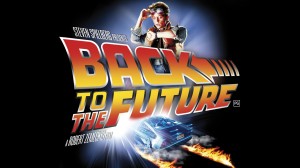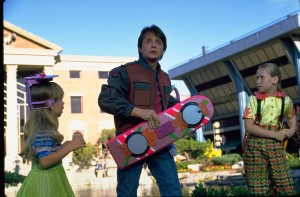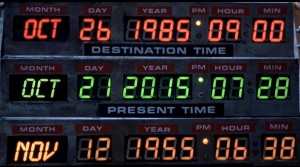
Marty McFly: “Uh, Jennifer, um, I don’t know how to tell you this, but I … you’re in a time machine.”
Jennifer: “And this is the year 2015?”
Doc: “October 21, 2015.”
We’ve almost caught up to Marty McFly, but has he caught up to us?
The “Back to the Future” trilogy was a hit in the ’80s and ’90s. The movies were suitable for all ages, so the trilogy became popular among many. “I remember loving those movies, especially the one where they went to the future,” BYU alumnus Sean Sibbett said. “It was cool to watch that movie and imagine a future with all of that stuff.”
In “Back to the Future: Part II,” Marty McFly and Dr. Emmett Brown visit the year 2015. They witness many futuristic technologies in 2015 that were unfathomable to them at the time.
The movie’s version of 2015 is still a little far fetched in some technological areas, though technology has made great advances since the ’80s.
Hoverboards

Hovercraft technology doesn’t come close to the hoverboard McFly rode, but inventors continue to press forward. A company named HUVr released a video in March 2014 featuring Moby, Christopher Lloyd, Tony Hawk and Terell Owens riding HUVr’s hoverboard.
The video shows a board with the same functionality as a “Back to the Future” board, making excited fans think their time had come. Fans were disappointed to find out the video was a hoax.
Sibbett said he is hopeful that sometime in the near future we’ll have similar technology. “I’m disappointed that nobody has invented the hoverboard yet, because that would be sweet to have,” he said.
Hoverboards in the form of AirWheels and Flywheels have hit markets, though, and many are jumping — or gliding — for joy. Some BYU students even own these self-balancing boards, making it the closest thing we have so far to McFly-style travel. These wheels range in price from $200 to $500.
Automated gas stations
In McFly’s 2015, gas stations provided customers with full service, eliminating all work on the customer’s part. The gas stations had a computerized attendant checking all items that personal attendants used to do in 1955.
Customers today still have to manually fill up their own tanks, but now they have the option to pay at the kiosk or inside the gas station. In Oregon and New Jersey, gas attendants are required to provide full service to cars; it’s the law.
But automated attendants may not be too far off. Information technology research firm Garter predicted last year that by the year 2025, one-third of U.S. jobs will be converted to the hands of software, robots and smart machines, according to PBS.
Holographic films and billboards
3D movies are similar to the holofilms in the movie. Today’s technology allows users to wear 3D glasses and watch a movie that appears to jump out at them. Similar to holofilms, the movie also had holobillboards. According to Horror Fan Zine’s online magazine, we’re in the third wave of the resurgence of 3D movies, starting in 2004 with the success of The Polar Express.
2008 and 2009 saw more 3D hits like Avatar, Monsters vs. Aliens and Final Destination, and now, nearly every movie is offered in a 3D experience.
Holobillboards have yet to be invented, but digital, LED billboards are becoming popular.
Thumb pads
Thumb pads frequently appeared in “Back to the Future: Part II.” These pads allowed users to use their thumb prints in order to gain access to get inside a home, and thumb pads replaced currency. Thumb pads were on the market at the time the movie was released.
Products like the iPhone 5S have fingerprint-recognition software similar to the thumb pad concept. With the use of Apple’s Apple Pay on the iPhone 6, users can make purchases almost magically using their phone and the touch of the thumb.
Video telephones
Like the video telephone in “Back to the Future: Part II,” telephones in the 21st Century offer video call functions such as FaceTime and Skype. Video phone calls allow people who live countries apart to communicate almost face to face.
In the movie, McFly’s children are seen wearing video glasses. They could watch TV without a large screen or talk on the phone through a video call. Inventions like the Google Glass provide users with functions similar to a hands-free smartphone.
Skyway
McFly witnessed cars flying in the ‘skyway.’ Prototypes like the Moller Skycar exist, but commercial flying cars have yet to be invented. Controlled airspace for aircraft is the closest thing that exists to a ‘skyway.’
Flying cars may not be around, but airplane technology continues to improve.
Auto-adjusting and auto-drying jackets
McFly had a jacket that was set to automatically adjust to his size at the touch of a button and would automatically dry when wet.
An auto-adjusting and auto-drying jacket has not been invented yet, but clothing materials have advanced. Now some clothing designs adjust to the wearer based on the outside temperature.

New technology
The real 2015 does not have the same things Marty McFly saw, but there are things it does have that weren’t predicted.
Electric cars have been developed instead of flying cars. “Back to the Future” showed a device that converted trash to gas, but having an electric car may be as close as we can get for now.
Electric car drivers no longer have to worry about gas costs. Instead they have to worry about where to find the nearest outlet and, consequently, the price of fossil fuels.
Google’s driverless cars re-imagine a world where accidents are rare and relaxation is abundant. Google currently has a fleet of 48 driverless cars that it is currently testing out on roads around the country, according to the Associated Press. GM has also been working on its own fleet of these smarter cars. Mercedes, Tesla and BMW are also in the race to create more efficient self-driving cars.
Smart watches are also prominent in today’s world. Samsung, Sony and Apple have all released watches in 2014 that function similarly to smartphones, but wear the same as any other watch.
Instead of chunky computers, people now have dozens of portable device options like tablets, phablets, Kindles, iPads and other screens that function on Wi-Fi.
“Back to the Future: Part II” gave viewers ideas of what the future of technology held, and 2015 will bring even more technologies that seemed impossible.




